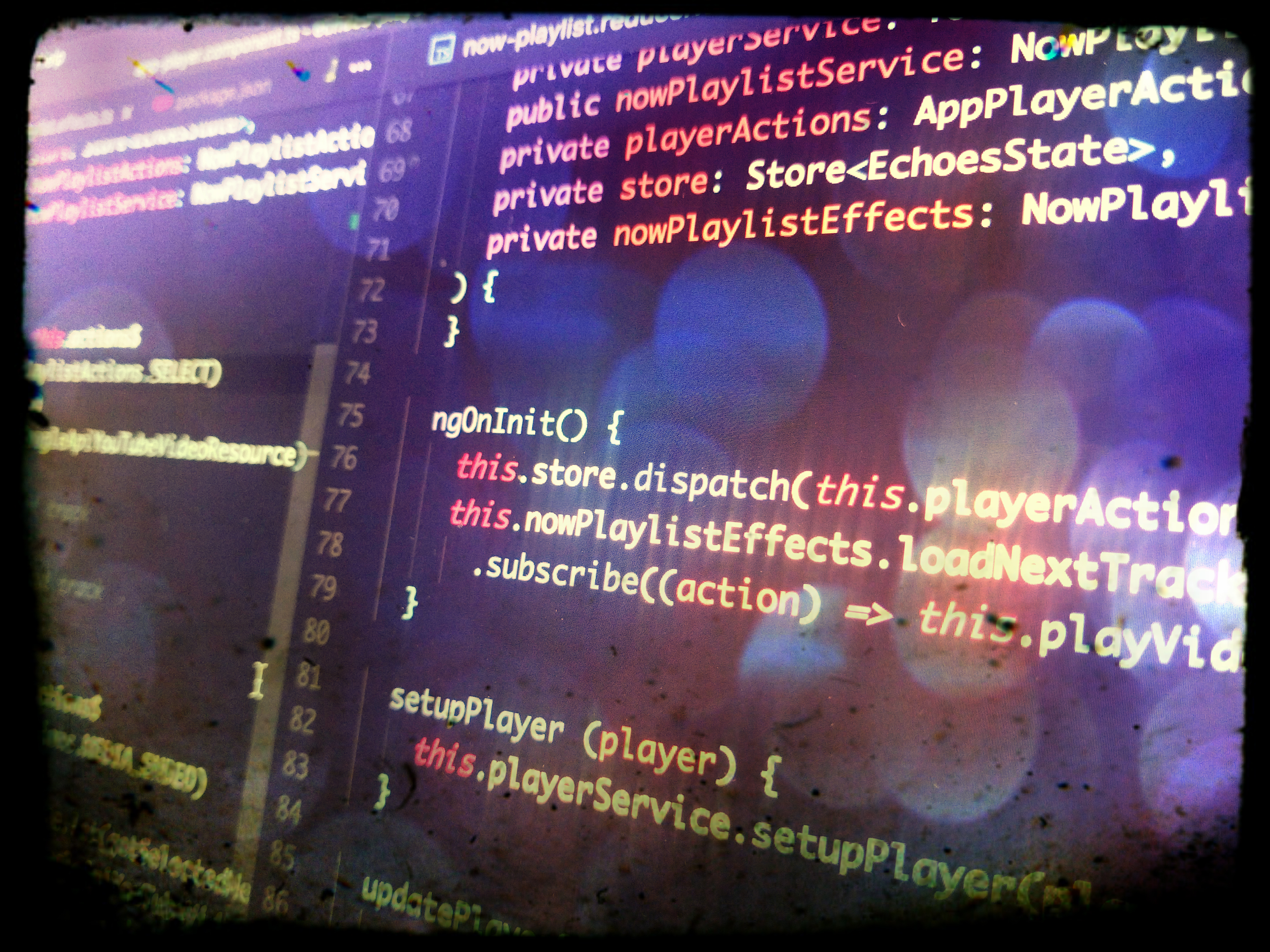 rizens
rizens
After upgrading my open source project, ”Echoes Player”, to work with the latest stable angular-cli 1.0 version (wrote an article about it), I set down to refactor the application’s code. I always like to look at implementations few times and experiment with several approaches. This time, I wanted to take advantage of ngrx/effects observables and understand how those can be reused. In this post I’m sharing my take on reusing ngrx/effects in order to communicate between two different reducers.
The refactor of the code was done in the process of adding a ”repeat” feature for the “Echoes Player” controls interface. Until this feature was released, the playlist in the player played the playlist repeatedly. As good as it sounds, the music never stops in “Echoes Player”, however, I wanted to add the ability to choose between “party” mode (repeat) and “only once” mode. To make it clear enough: The YouTube player doesn’t have a dynamic & customized playlist feature like the one in “Echoes Player”.
I’ve written before about the various components, services, reducers and side effects in “Echoes Player” and I also published a book on learning reactive programming with Angular & ngrx. However, these are the main components and services that take part in the sequence for loading the next track:
The scenario for loading the next track is handled by a side effect to an action. These are the steps in the sequence:
Steps 4 and 5 are resolved in two different reducers. We could inject the “AppPlayerActions” into the now-playlist effects class, however, that breaks the ”Single Responsibility Rule (SRP)” for this effects class - as it supposed to serve the now-playlist actions scenarios.
The “AppPlayer” Component is responsible for emitting the “MEDIA_ENDED” event. In the code snippet below, i’m using the youtube-player component (another open source component available in npm that I released as a side effect of this player) custom “change()” event to update the application with the player’s state:
@Component({
selector: "app-player",
template: `
<section
[class.show-youtube-player]="(player$ | async).showPlayer"
[class.fullscreen]="(player$ | async).isFullscreen"
>
<div class="yt-player ux-maker">
...
<youtube-player
class="nicer-ux"
(ready)="setupPlayer($event)"
(change)="updatePlayerState($event)"
></youtube-player>
</div>
...
</section>
`,
})
export class AppPlayerComponent implements OnInit {
constructor(
private playerService: YoutubePlayerService,
public nowPlaylistService: NowPlaylistService,
private playerActions: AppPlayerActions,
private store: Store<EchoesState>
) {}
updatePlayerState(event) {
this.playerService.onPlayerStateChange(event)
if (event.data === YT.PlayerState.ENDED) {
this.nowPlaylistService.trackEnded()
}
}
}When the “repeat” feature wasn’t available, playing the next track was quite easy: the player should emit a play action and take the currently selected media to be played using the Youtube Player Service. Actually, this was the previous “updatePlayerState()” code:
updatePlayerState (event) {
this.playerService.onPlayerStateChange(event);
if (event.data === YT.PlayerState.ENDED) {
this.nowPlaylistService.trackEnded();
this.store.dispatch(this.playerActions.playVideo(this.nowPlaylistService.getCurrent()));
}
}This worked for the purpose of just keep playing the next available track. However, to support the “repeat” feature, I had to think of another way and I wanted to think in a reactive programming style while reusing code that is already written.
The ”trackEnded()” method invoked the “MEDIA_ENDED” action. This action is handled in the “now-playlist” reducer which runs the ”selectNextOrPreviousTrack()”. This function updates the “selectedId” property in the reducer. If “repeat” is “on” and it’s the end of the playlist, the playlist should not select the first track as the new selected track to play - an empty string indicates this state.
function selectNextOrPreviousTrack(
state: NowPlaylistInterface,
filter: string
): NowPlaylistInterface {
const videosPlaylist = state.videos
const currentId = state.selectedId
const indexOfCurrentVideo = videosPlaylist.findIndex(
video => currentId === video.id
)
const isCurrentLast = indexOfCurrentVideo + 1 === videosPlaylist.length
const nextId = isCurrentLast
? getNextIdForPlaylist(videosPlaylist, state.repeat, currentId)
: selectNextIndex(videosPlaylist, currentId, filter, state.repeat)
return Object.assign({}, state, { selectedId: nextId })
}
function getNextIdForPlaylist(
videos: GoogleApiYouTubeVideoResource[],
repeat: boolean,
currentId: string = ""
) {
let id = ""
if (videos.length && repeat) {
id = videos[0].id
}
return id
}The side effect that runs after the selected media has been updated, is supposed to emit a “selectVideo” action when the right conditions exists. To achieve that, first, it takes the latest state for the selected media object. Next, the ”filter” operator checks whether the selected media is valid for playing the video - when the playlist is over, the “selectedId” property is set to an empty string, so in this case, there would not be any valid media object to play. This means that the side effect will not emit the “selectVideo” action if the filter function result is an invalid condition for selecting the next video.
@Effect()
loadNextTrack$ = this.actions$
.ofType(NowPlaylistActions.MEDIA_ENDED)
.map(toPayload)
.withLatestFrom(this.store.let(getSelectedMedia$))
.filter((states: [any, GoogleApiYouTubeVideoResource]) => states[1] && states[1].hasOwnProperty('id'))
.map((states: [any, GoogleApiYouTubeVideoResource]) => {
return this.nowPlaylistActions.selectVideo(states[1]);
}).share();This sequence just selects the next video in the playlist - it doesn’t play it. Now it’s time to integrate the actual action which triggers the ”PLAY” action.
Lets understand the result of creating a side effect - aka - invoking the ”@Effect()” decorator. Eventually, the ”this.actions$” sequence returns an observable object to the ”loadNextTrack$” property. This means that the ”loadNextTrack$” can be subscribed with an observer.
Notice that I added the “share()” operator at the end of the Effect’s sequence. As reader Brett Coffin suggested, since both the store and the following subscribe to this effect, using “share()” will create only one execution for both subscription rather than running the effect chain twice.
Each ”Effects” class is an injectable service. This gives us the opportunity to inject the ”NowPlaylistEffects” class to the constructor of the “AppPlayer” component.
constructor(
private playerService: YoutubePlayerService,
public nowPlaylistService: NowPlaylistService,
private playerActions: AppPlayerActions,
private store: Store<EchoesState>,
private nowPlaylistEffects: NowPlaylistEffects
) {
}Now, in the ”ngOnInit” life cycle, the component subscribes to the ”loadNextTrack$” side effect and triggers a ”PLAY” action with the payload of this action - the next selected media to play. Since the side effect filters scenarios where the track is last and repeat is not on, this subscription won’t be triggered. It’s important to note that defining this behavior - playing video after this side effect has triggered - will always happen - so, it’s important to design and define the requirement.
// AppPlayerComponent
ngOnInit() {
this.nowPlaylistEffects.loadNextTrack$
.subscribe((action) => this.playVideo(action.payload));
}
...
playVideo (media: GoogleApiYouTubeVideoResource) {
this.store.dispatch(this.playerActions.playVideo(media));
}
Since the ”AppPlayerComponent” is a container component (SMART), there’s no need to unsubscribe from this subscription. Otherwise, this subscription should be disposed as:
// AppPlayerComponent
private nowPlaylistSub: Subscription;
ngOnInit() {
this.store.dispatch(this.playerActions.reset());
this.nowPlaylistSub = this.nowPlaylistEffects.loadNextTrack$
.subscribe((action) => this.playVideo(action.payload));
}
ngOnDestroy() {
this.nowPlaylistSub.unsubscribe();
}That sums up the reuse of the “NowPlaylist” effects and the concept of communicating between two reducers or more. ”Echoes Player” is an open source project - feel free to suggest better alternatives, feature requests and other suggestions as well.
My new book - ”Reactive Programming With Angular & ngrx extensions” - is soon to be release through Apress Media (expected date is June 2017). This book walks through the creation process of a liter version of Echoes while understanding the concepts of reactive programming with RxJs, Angular and ngrx extensions - ngrx/store & ngrx/effects.
If you’re looking for Angular Consulting / Front End Consulting or High Quality Javascript Development, please consider to approach via the promotion packages below (no strings attached):